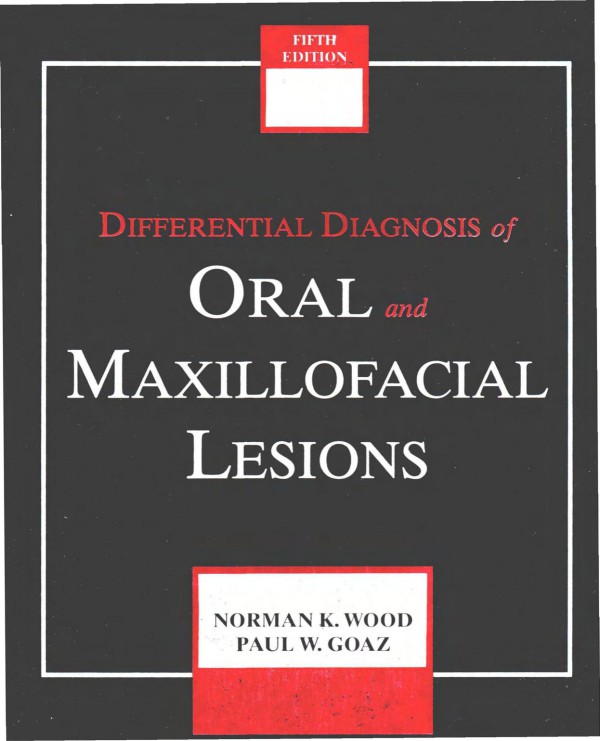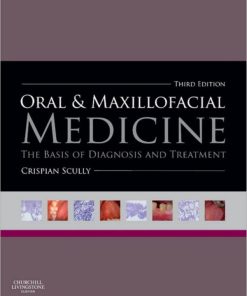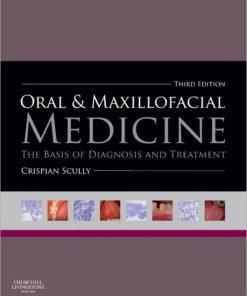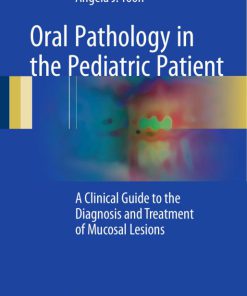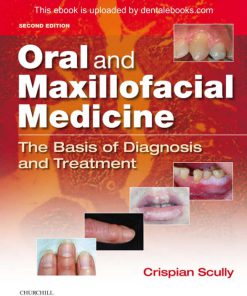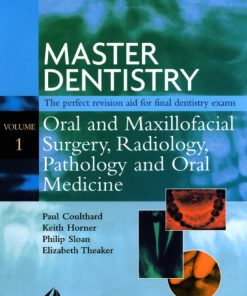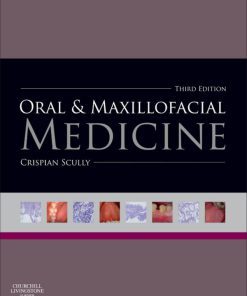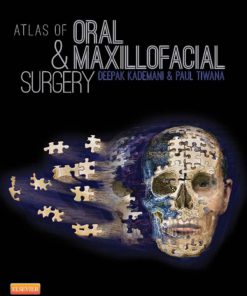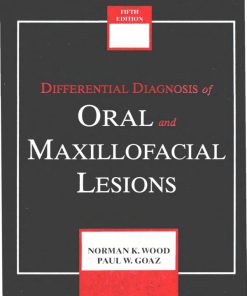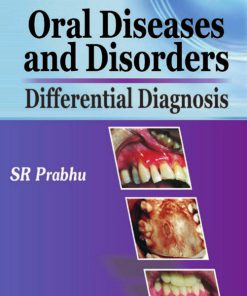Differential Diagnosis of Oral and Maxillofacial Lesions 5th Edition by Paul Goaz ISBN 0815194323
$50.00 Original price was: $50.00.$25.00Current price is: $25.00.
Authors:Mosby; 5 edition (January 15, 1997) , Author sort:edition, Mosby; 5 , Published:Published:Jun 2006
Differential Diagnosis of Oral and Maxillofacial Lesions 5th Edition by Paul Goaz – Ebook PDF Instant Download/Delivery. 0815194323
Full download Differential Diagnosis of Oral and Maxillofacial Lesions 5th Edition after payment
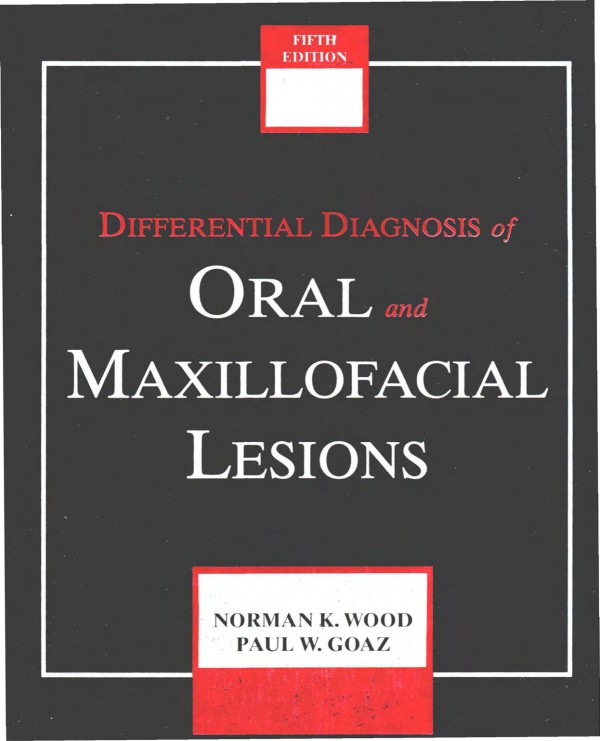
Product details:
ISBN 10: 0815194323
ISBN 13:
Author: Paul Goaz
This text provides students and practitioners with the essential diagnostic information for clinical problems as well as a system for differentiation of diseases that have similar signs, symptoms, and radiographic appearance. Pathogenesis, clinical, radiographic, laboratory, and histopathological features are presented with discussion developed especially to highlight distinguishing features and helpful hints in generating a differential diagnosis for each lesion.
Differential Diagnosis of Oral and Maxillofacial Lesions 5th Table of contents:
CHAPTER 1 Introduction
REFERENCE
PART I GENERAL PRINCIPLES OF DIFFERENTIAL DIAGNOSIS
CHAPTER 2 History and Examination of the Patient
HISTORY AND PHYSICAL EXAMINATION
Radiologic Examination
Panoramic radiography.
Conventional tomography (laminography)
Computer-Assisted Imaging
Fig. 2-1. Lateral tomography of right temporomandibular joint.
Digital radiography
Subtraction radiography.
Fig. 2-2.
Computed tomography
Radionuclide imaging
Fig. 2-3.
Magnetic resonance imaging
Fig. 2-4. Computed tomography scan illustrating artifacts produced by metal dental restorations.
Fig. 2-5.
Sonography
DIFFERENTIAL DIAGNOSIS
Working Diagnosis
Medical Laboratory Studies
Dental Laboratory Studies
Fig. 2-6.
Biopsy
Fig. 2-7.
Excisional biopsy
Incisional biopsy
Fine-needle aspiration
Fig. 2-8.
Exfoliative Cytology
Toluidine Blue Staining
Consultation
FINAL DIAGNOSIS
TREATMENT
REFERENCES
CHAPTER 3 Correlation of Gross Structure and Microstructure with Clinical Features
IMPORTANCE OF NORMAL ANATOMY AND HISTOLOGY TO THE DIAGNOSTICIAN
Oral and Perioral Systems
Oral and Perioral Tissues
Fig. 3-1.
Fig. 3-1, cont’d.
EXPLANATION OF CLINICAL FEATURES IN TERMS OF NORMAL AND ALTERED TISSUE STRUCTURE AND FUNCTION
Features Obtained by Inspection
Contours
Color
Pink.
Fig. 3-2.
White.
Fig. 3-2, cont’d.
Yellow.
Brownish, bluish, or black.
Fig. 3-3.
Surfaces
Fig. 3-4.
Fig. 3-5.
Flat and raised entities.
Aspiration
Fig. 3-6.
Fig. 3-7.
Fig. 3-8.
Fig. 3-9.
Table 3-1 Smooth-surfaced and rough-surfaced masses
Fig. 3-10.
Aspirate.
Fig. 3-11.
Fig. 3-12.
Fig. 3-13.
Needle biopsy
Features Obtained by Palpation
Surface temperature
Anatomic regions and planes involved
Mobility
Fig. 3-14.
Fig. 3-15.
Fig. 3-16.
Extent
Borders of the mass.
Fig. 3-17.
Consistency of surrounding tissue
Thickness of overlying tissue
Sturdiness of underlying tissue
Size and shape
Consistency
Fluctuance and emptiability
Table 3-2 Consistency of normal tissues and organs*
Fig. 3-18.
Fig. 3-18, cont’d.
Table 3-3 Consistency of pathologic masses
Fig. 3-19.
Fig. 3-19, cont’d.
Lesions demonstrating variable fluctuance.
Fig. 3-20. Diagram illustrating fluctuance in a cystlike lesion.
Table 3-4 Characteristics of soft, cheesy, or rubbery masses
Painless, tender, or painful
Fig. 3-21.
Fig. 3-22. Diagram of muscle overlying a cyst and masking its characteristics.
Fig. 3-23. Diagram illustrating a nonemptiable cystlike lesion.
Table 3-5 Painless, tender, and painful masses
Fig. 3-24. Diagram illustrating complete emptiability in an aneurysm-like lesion.
Fig. 3-25. Diagram illustrating the difficulty encountered in attempting to completely empty a capillary hemangioma, which has many small channels and few exit vessels.
Fig. 3-26. Diagram illustrating a pedunculated capillary hemangioma, which would be nonemptiable by digital pressure.
Fig. 3-27.
Fig. 3-28.
Unilateral or bilateral
Solitary or multiple
Features Obtained by Percussion
Features Obtained by Auscultation
CHAPTER 4 The Diagnostic Sequence
DETECTION AND EXAMINATION OF THE PATIENT’S LESION
EXAMINATION OF THE PATIENT
Chief Complaint(s)
Pain
Sores
Burning sensation
Bleeding
Loose teeth
Recent occlusal problem
Delayed tooth eruption
Dry mouth (xerostomia)
Too much saliva
Swelling
Bad taste
Halitosis
Paresthesia and anesthesia
Onset and Course
REEXAMINATION OF THE LESION
CLASSIFICATION OF THE LESION
LIST OF THE POSSIBLE DIAGNOSES
DEVELOPMENT OF THE DIFFERENTIAL DIAGNOSIS
Age
Gender
Race
Country of Origin
Anatomic Location
PREDILECTION OF SOFT TISSUE LESIONS FOR SPECIAL AGE-GROUPS
Infants
Children
Persons Under Age 40
Persons Over Age 40
PREDISPOSITION OF BONY OR CALCIFIED LESIONS FOR SPECIAL AGE-GROUPS
Infants
Children
Persons Under Age 30
Persons Over Age 30
Persons Over Age 40
TWO OR MORE LESIONS PRESENT
GENDER PREDILECTION OF SOFT TISSUE LESIONS (RATIOS OR PERCENTS ARE GIVEN IN PARENTHESES)
Male
Female
GENDER PREDISPOSITION OF BONY LESIONS
Male
Female
DEVELOPING THE WORKING DIAGNOSIS (OPERATIONAL DIAGNOSIS, TENTATIVE DIAGNOSIS, CLINICAL IMPRESSION)
JAWBONE AND REGIONAL PREDILECTION OF BONY LESIONS
Mandible and Predominant Region
Maxilla and Predominant Region
Rare in Maxilla
FORMULATING THE FINAL DIAGNOSIS
REFERENCES
PART II SOFT TISSUE LESIONS
Soft Tissue Lesions
CHAPTER 5 Solitary Red Lesions
NORMAL VARIATION IN ORAL MUCOSA
Masticatory and Lining Mucosa
Fig. 5-1. Clinical view showing the paler pink of the attached gingiva (masticatory mucosa) in contrast to the deeper pink of the vestibular mucosa (lining mucosa).
Palatoglossal Arch Region
PATHOLOGIC RED LESIONS
Fig. 5-2. Note the red appearance of the palatoglossal arch (arrows) in this healthy asymptomatic patient.
TRAUMATIC ERYTHEMATOUS MACULES AND EROSIONS
Fig. 5-3.
RESPONSE TO TRAUMA
Features
Fig. 5-4.
Differential Diagnosis
Management
PURPURIC MACULES (EARLY STAGE)
Features
Differential Diagnosis
Management
INFLAMMATORY HYPERPLASIA LESIONS
Features
Fig. 5-5.
DIFFERENTIAL DIAGNOSIS OF RED IH LESIONS
Differential Diagnosis
Management
REDDISH ULCERS OR ULCERS WITH RED HALOS
Differential Diagnosis
NONPYOGENIC SOFT TISSUE ODONTOGENIC INFECTION (CELLULITIS)
Features
Fig. 5-6. Reddened mucosa surrounding three recurrent aphthous ulcers in the floor of the mouth.
Differential Diagnosis
Management
CHEMICAL OR THERMAL ERYTHEMATOUS MACULE
Fig. 5-7.
Features
Differential Diagnosis
Fig. 5-8.
Fig. 5-9.
Management
NICOTINE STOMATITIS
Differential Diagnosis
ERYTHROPLAKIA, CARCINOMA IN SITU, AND RED MACULAR SQUAMOUS CELL CARCINOMA
Features
Fig. 5-10.
Fig. 5-11.
Differential Diagnosis
Fig. 5-12.
DIFFERENTIAL DIAGNOSIS OF EP
Management
EXOPHYTIC, RED SQUAMOUS CELL CARCINOMA
Features
Fig. 5-13.
DIFFERENTIAL DIAGNOSIS OF ESCC
Differential Diagnosis
Management
CANDIDIASIS
Etiology and Pathogenesis
Fig. 5-14. Pseudohyphae of C. albicans in tissue. (Courtesy P. Fotos, Iowa City.)
PREDISPOSING CONDITIONS TO ORAL CANDIDIASIS
Drugs/Medications
Endocrinopathies
Hematologic Disorders
Immunodeficiency
Leukocyte Disorders
Malignancy
Nutritional Deficiencies
Other
Features
Diagnostic Procedure
CLINICAL LESIONS OF CANDIDIASIS
Management
Topical therapy
Nystatin.
Table 5-1 Drugs used in treatment of fungal disease
Clotrimazole.
Chlorhexidine.
Gentian violet.
Systemic therapy
Ketoconazole.
Fluconazole.
Amphotericin B.
Atrophic/Erythematous Candidiasis
Fig. 5-15.
Denture Stomatitis
Features
Differential diagnosis
Fig. 5-16.
Management
Angular Cheilitis
MACULAR HEMANGIOMAS AND TELANGIECTASIAS
Fig. 5-17.
Management
ALLERGIC MACULES
Fig. 5-18.
Fig. 5-19.
Fig. 5-20.
HERALD LESION OF GENERALIZED STOMATITIS OR VESICULOBULLOUS DISEASE
METASTATIC TUMORS TO SOFT TISSUE
Fig. 5-21.
Features
Fig. 5-22.
Differential Diagnosis
DIFFERENTIAL DIAGNOSIS OF RED METASTATIC TUMORS
Fig. 5-23.
Management
KAPOSI’S SARCOMA (AIDS)
RARITIES
REFERENCES
CHAPTER 6 Generalized Red Conditions and Multiple Ulcerations
ETIOLOGY
RECURRENT APHTHOUS STOMATITIS AND BEHçET’S SYNDROME
Features
Fig. 6-1.
Differential Diagnosis
Management
PRIMARY HERPETIC GINGIVOSTOMATITIS
Features
Differential Diagnosis
Fig. 6-2.
Establishment of diagnosis
Management
EROSIVE LICHEN PLANUS
Features
Lichenoid dysplasia
Fig. 6-3.
Differential Diagnosis
Special diagnostic procedures
Management
Table 6-1 Immunofluorescence findings important in the diagnosis of red conditions
Lichenoid Drug Reaction
Fig. 6-4.
ERYTHEMA MULTIFORME
Features
Fig. 6-5.
Differential Diagnosis
Management
ACUTE ATROPHIC CANDIDIASIS
Features
Fig. 6-6.
Differential Diagnosis
Management
BENIGN MUCOUS MEMBRANE PEMPHIGOID
Features
Fig. 6-7.
Fig. 6-8.
Differential Diagnosis
Management
PEMPHIGUS
Features
Fig. 6-9.
Differential Diagnosis
Special diagnostic procedures
Management
DESQUAMATIVE GINGIVITIS
Features
Differential Diagnosis
Management
Fig. 6-10.
CHRONIC ULCERATIVE STOMATITIS
Features
Differential Diagnosis
Management
Special diagnostic procedures
RADIATION AND CHEMOTHERAPY MUCOSITIDES
Radiation Mucositis
Features
Fig. 6-11.
Management
Chemotherapy Mucositis
Features
Management
XEROSTOMIA
Features
Differential Diagnosis
Management
Fig. 6-12. Diffuse and striking erythematous changes of plasma cell gingivitis are confined to the gingiva.
PLASMA CELL GINGIVITIS
Features
Differential Diagnosis
Management
Fig. 6-13. Stomatitis areata migrans on the buccal mucosa.
STOMATITIS AREATA MIGRANS
Features
Differential Diagnosis
Management
ALLERGIES
Fig. 6-14.
POLYCYTHEMIA
LUPUS ERYTHEMATOSUS
Features
Differential Diagnosis
Special Diagnostic Procedures
Serum findings
Biopsy findings
Management
RARITIES
Fig. 6-15.
Fig. 6-16.
Fig. 6-17.
REFERENCES
CHAPTER 7 Red Conditions of the Tongue
MIGRATORY GLOSSITIS
Features
Differential Diagnosis
Fig. 7-1.
Fig. 7-2.
Management
MEDIAN RHOMBOID GLOSSITIS
Features
Differential Diagnosis
Management
DEFICIENCY STATES
Features
Fig. 7-3.
Fig. 7-4. A small but relatively typical lesion of MRG.
Fig. 7-5. Classic appearance of MRG.
Differential Diagnosis
Management
XEROSTOMIA
RARITIES
Fig. 7-6.
Fig. 7-7.
Fig. 7-8.
REFERENCES
CHAPTER 8 White Lesions of the Oral Mucosa
KERATOTIC WHITE ENTITIES
LEUKOEDEMA
Fig. 8-1.
Fig. 8-2. The attached gingiva (masticatory mucosa) is a paler pink than the vestibular (lining) mucosa because of the keratinized surface and less vascularity.
Features
Fig. 8-3.
Differential Diagnosis
Management
LINEA ALBA BUCCALIS
Fig. 8-4.
LEUKOPLAKIA
Fig. 8-5.
ETIOLOGIC FACTORS OF LEUKOPLAKIA
Features
Fig. 8-6.
Classifications
Clinical appearance
Fig. 8-7.
Histologic study
Reversible or irreversible types
CLINICAL TYPES OF LEUKOPLAKIA
Malignant potential
Differential Diagnosis
Fig. 8-8.
HIGH-RISK LEUKOPLAKIAS
DIFFERENTIAL DIAGNOSIS OF HOMOGENEOUS LEUKOPLAKIA
Fig. 8-9.
Fig. 8-10.
Management
NICOTINE STOMATITIS
Fig. 8-11.
CIGARETTE SMOKER’S LIP LESION
SMOKELESS TOBACCO LESION
ORAL EFFECTS OF SMOKELESS TOBACCO
Features
Fig. 8-12.
Malignant potential
Histopathology
Management
Fig. 8-13.
MIGRATORY GLOSSITIS
PERIPHERAL SCAR TISSUE
LICHEN PLANUS
Fig. 8-14.
Malignancy Potential
Clinical Features
Fig. 8-15.
Fig. 8-16.
CLINICAL PATTERNS OF KERATOTIC LP (FIG. 8-17 AND FIG. 8-18)
Histopathologic Features
Differential Diagnosis
Fig. 8-17.
Fig. 8-18.
Fig. 8-19.
Management
Fig. 8-20.
LICHENOID DRUG REACTION
ELECTROGALVANIC AND MERCURY CONTACT ALLERGY
Fig. 8-21.
WHITE HAIRY TONGUE
DIFFERENTIAL DIAGNOSIS FOR WHITE EXOPHYTIC SCC
PAPILLOMA, VERRUCA VULGARIS, AND CONDYLOMA ACUMINATUM
WHITE EXOPHYTIC SCC
Features
Fig. 8-22.
Fig. 8-23.
Fig. 8-24.
Differential Diagnosis
Management
VERRUCOUS CARCINOMA
Features
Fig. 8-25.
Microscopic Features
Proliferative Verrucous Leukoplakia
Verrucous Hyperplasia vs. VC
Fig. 8-26.
Differential Diagnosis
Management
HYPERTROPHIC OR HYPERPLASTIC CANDIDIASIS
Fig. 8-27.
Fig. 8-28.
DIFFERENTIAL DIAGNOSIS FOR WHITE SPONGE NEVUS
HAIRY LEUKOPLAKIA
WHITE SPONGE NEVUS
Features
Fig. 8-29.
Differential Diagnosis
Fig. 8-30.
Fig. 8-31.
Microscopic Features
Management
SKIN GRAFTS
Fig. 8-32.
Fig. 8-33. Superficial keratin-filled lymphoepithelial cyst in the sublingual area of an infant.
Fig. 8-34.
Fig. 8-35. Granular cell lesion, which had a yellowish-white cast.
Fig. 8-36.
Fig. 8-37.
Fig. 8-38.
Fig. 8-39.
RARITIES
SLOUGHING, PSEUDOMEMBRANOUS, NECROTIC WHITE LESIONS
PLAQUE
Fig. 8-40. Arrow indicates white plaque (materia alba) that can be easily removed.
Fig. 8-41.
TRAUMATIC ULCER
PYOGENIC GRANULOMA
CHEMICAL BURNS
Fig. 8-42.
Fig. 8-43.
ACUTE NECROTIZING ULCERATIVE GINGIVITIS
Features
Fig. 8-44.
Differential Diagnosis
Management
Severe cases
Fig. 8-45.
Mild to moderate cases
CANDIDIASIS
Features
Differential Diagnosis
Fig. 8-46. Candidiasis on the dorsal surface of the tongue.
DIFFERENTIAL DIAGNOSIS OF PSEUDOMEMBRANOUS CANDIDIASIS
Fig. 8-47.
Fig. 8-48.
Management
NECROTIC ULCERS OF SYSTEMIC DISEASE
DIFFUSE GANGRENOUS STOMATITIS
Features
Fig. 8-49.
Differential Diagnosis
Management
RARITIES
REFERENCES
CHAPTER 9 Red and White Lesions
RED AND WHITE LESIONS WITH KERATOTIC COMPONENTS
RED LESIONS WITH NECROTIC COMPONENT
VESICULOBULLOUS LESIONS
CHAPTER 10 Peripheral Oral Exophytic Lesions
Fig. 10-1.
EXOPHYTIC ANATOMIC STRUCTURES
EXOPHYTIC ANATOMIC STRUCTURES
Fig. 10-2. Buccal fat pads.
Fig. 10-3. Foliate papillae.
Fig. 10-4.
EXOPHYTIC LESIONS
TORI AND EXOSTOSES
Differential Diagnosis
Fig. 10-5.
Fig. 10-6.
Management
INFLAMMATORY HYPERPLASIAS
PREVIOUS CLINICAL TERMS
Clinical Terms
Fig. 10-7.
Differential Diagnosis
DIFFERENTIAL DIAGNOSIS OF IH
Management
FIBROUS HYPERPLASIA
Fig. 10-8.
Fig. 10-9.
Pyogenic Granuloma
Fig. 10-10.
Hormonal Tumor
Fig. 10-11. Epulis fissuratum.
Epulis Fissuratum
Features
Fig. 10-12.
Differential diagnosis
Management
Fig. 10-13.
Parulis
Papillary Hyperplasia of the Palate
Fig. 10-14.
Features
Differential diagnosis
Management
Peripheral Giant Cell Lesion
Features
Fig. 10-15.
Differential diagnosis
Management
Pulp Polyp
Fig. 10-16. Pulp polyp.
Differential diagnosis
Management
Epulis Granulomatosum
Differential diagnosis
Fig. 10-17.
Management
Acquired Hemangioma
DIFFERENTIAL LIST FOR PFC
Peripheral Fibroma with Calcification
Features
Fig. 10-18.
Differential diagnosis
Management
MUCOCELE AND RANULA
Differential Diagnosis
Management
HEMANGIOMA, LYMPHANGIOMA, AND VARICOSITY
Fig. 10-19.
CENTRAL EXOPHYTIC LESIONS
HPV STRAINS ASSOCIATED WITH CLINICAL LESIONS
Oral Papilloma, Verruca Vulgaris, and Condyloma Acuminatum
Fig. 10-20.
Features
Fig. 10-21.
Differential Diagnosis
Management
EXOPHYTIC SQUAMOUS CELL CARCINOMA
Fig. 10-22.
Fig. 10-23.
Fig. 10-24.
Features
Differential Diagnosis
DIFFERENTIAL LIST OF SMALL, ROUGH-SURFACED EXOPHYTIC LESIONS
DIFFERENTIAL LIST OF LARGE, FULMINATING MASSES
Fig. 10-25.
Management
VERRUCOUS CARCINOMA
MINOR SALIVARY GLAND TUMORS
CLASSIFICATION OF BENIGN SGTS AND ADENOMAS
Benign vs. Malignant
CLASSIFICATION OF SALIVARY GLAND ADENOCARCINOMAS
Classification According to Biologic Behavior
BENIGN VS. MALIGNANT FEATURES
FIRM MINOR SGTS
MODERATELY SOFT MINOR SGTS
Features
Fig. 10-26.
Fig. 10-27.
DIFFERENTIAL LIST FOR FIRM MINOR SGT
Differential Diagnosis
Firm minor SGTs
Soft minor SGTs
DIFFERENTIAL LIST FOR SOFT MINOR SGT
Ulcerated minor SGTs
Management
Fig. 10-28.
Fig. 10-29.
PERIPHERAL BENIGN MESENCHYMAL TUMORS
Features
Fig. 10-30.
Differential Diagnosis
Management
NEVUS AND MELANOMA
Fig. 10-31.
PERIPHERAL METASTATIC TUMORS
Differential Diagnosis
Management
PERIPHERAL MALIGNANT MESENCHYMAL TUMORS
Fig. 10-32.
Fig. 10-33.
Fig. 10-34.
Fig. 10-35.
Fig. 10-36.
Fig. 10-37.
Fig. 10-38.
Fig. 10-39.
RARITIES
Solitary Lesions
Multiple Lesions
REFERENCES
CHAPTER 11 Solitary Oral Ulcers and Fissures
ULCERS
Fig. 11-1.
Fig. 11-2.
TRAUMATIC ULCER
Features
Fig. 11-3.
Differential Diagnosis
Management
Table 11-1 RAU and RIHS: dissimilar features
RAU AND RIHS: COMMON FEATURES
Fig. 11-4.
RECURRENT ORAL ULCERS
Recurrent Aphthous Ulcer
Pathogenesis
Fig.11-5.
Features
Differential diagnosis
Management
Recurrent Intraoral Herpes Simplex
Pathogenesis
ATYPICAL RIHS
Fig. 11-6.
Features
Fig. 11-7.
Differential diagnosis
Fig. 11-8.
Atypical RIHS Lesions
Fig. 11-9.
Management
Major Recurrent Aphthous Ulcer
Fig. 11-10.
Herpetiform Aphtha
Behçet’s Syndrome
ULCERS FROM ODONTOGENIC INFECTIONS
Features
Differential Diagnosis
Fig. 11-11.
Management
SLOUGHING, PSEUDOMEMBRANOUS ULCERS
GENERALIZED MUCOSITIDES AND VESICULOBULLOUS DISEASES
SQUAMOUS CELL CARCINOMA
Features
Fig. 11-12.
Fig. 11-13.
Differential Diagnosis
Management
SYPHILIS (CHANCRE AND GUMMA)
Chancre
Features
Differential diagnosis
Management
Gumma
Fig. 11-14.
Features
Differential diagnosis
Management
ULCERS SECONDARY TO SYSTEMIC DISEASE
Fig. 11-15.
Features
Fig. 11-16.
Differential Diagnosis
Management
Fig. 11-17.
TRAUMATIZED TUMORS (TYPES USUALLY NOT ULCERATED)
Fig. 11-18.
MINOR SALIVARY GLAND TUMORS
Differential Diagnosis
DIFFERENTIAL LIST OF SHORT-TERM ULCERS
RARITIES
DIFFERENTIAL DIAGNOSIS OF ORAL ULCERS
DIFFERENTIAL LIST OF PERSISTENT ULCERS
Short-Term Ulcers
Persistent Ulcers
Fig. 11-19.
FISSURES
REFERENCES
CHAPTER 12 Intraoral Brownish, Bluish, or Black Conditions
Fig. 12-1.
DISTINCT CIRCUMSCRIBED TYPES
MELANOPLAKIA
Features
Differential Diagnosis
Management
Fig. 12-2.
DIFFERENTIAL LIST FOR MELANOPLAKIA
SMOKER’S MUCOSAL MELANOSIS
Features
Fig. 12-3.
Differential Diagnosis
Treatment
VARICOSITY
Features
DIFFERENTIAL LIST FOR BULBOUS VARICOSITY
Differential Diagnosis
Fig. 12-4.
Management
AMALGAM TATTOO
Fig. 12-5.
Differential Diagnosis
Management
PETECHIA AND ECCHYMOSIS (PURPURA)
Features
Differential Diagnosis
Fig. 12-6.
Fig. 12-7.
DIAGNOSTIC LIST FOR PALATINE PETECHIAE
Fig. 12-8.
Management
EARLY HEMATOMA
Differential Diagnosis
Fig. 12-9.
Management
LATE HEMATOMA
Differential Diagnosis
Management
HEMANGIOMA
Fig. 12-10.
Differential Diagnosis
Management
Fig. 12-11.
ORAL MELANOTIC MACULE
Fig. 12-12. Oral melanotic macule of the lower lip.
Features
Differential Diagnosis
Management
MUCOCELE
Features
Fig. 12-13.
Differential Diagnosis
Management
RANULA
Features
Differential Diagnosis
Management
Fig. 12-14.
SUPERFICIAL CYST
Fig. 12-15.
Differential Diagnosis
Management
GIANT CELL GRANULOMA
Differential Diagnosis
Fig. 12-16.
BLACK HAIRY TONGUE
Management
LYMPHANGIOMA
Features
Fig. 12-17.
Differential Diagnosis
Management
“PIGMENTED” FIBROUS HYPERPLASIA
MELANOMA
RISK FACTORS FOR CUTANEOUS MELANOMA
Fig. 12-18.
SUSPICIOUS CHANGES IN NEVI
ORAL MELANOMA
Fig. 12-19.
Features
DIFFERENTIAL LIST FOR ORAL MELANOMA
Differential Diagnosis
Management
ORAL NEVUS
Fig. 12-20.
Differential Diagnosis
Management
MUCUS-PRODUCING SALIVARY GLAND TUMORS
Differential Diagnosis
Fig. 12-21. Low-grade mucoepidermoid tumor showing pools of mucus (m) Such a lesion may clinically mimic a mucocele.
Management
VON RECKLINGHAUSEN’S DISEASE (MULTIPLE NEUROFIBROMATOSIS)
Differential Diagnosis
Management
ALBRIGHT’S SYNDROME
Fig. 12-22.
Differential Diagnosis
Management
HEAVY METAL LINES
Fig. 12-23.
Fig. 12-24.
Fig. 12-25.
Fig. 12-26.
KAPOSI’S SARCOMA
RARITIES
GENERALIZED BROWNISH, BLUISH, OR BLACK CONDITIONS
CYANOSIS
Differential Diagnosis
Management
CHLOASMA GRAVIDARUM
ADDISON’S DISEASE
Differential Diagnosis
Management
HEMOCHROMATOSIS (BRONZE DIABETES)
Differential Diagnosis
Management
ARGYRIA (SILVER PIGMENTATION)
Differential Diagnosis
Management
RARITIES
REFERENCES
CHAPTER 13 Pits, Fistulae, and Draining Lesions
PITS
FOVEA PALATINAE
COMMISSURAL LIP PIT
Differential Diagnosis
Management
POSTSURGICAL PIT
Differential Diagnosis
Fig. 13-1. Fovea palatinae on the anterior aspect of the soft palate.
Fig. 13-2.
Management
POSTINFECTION PIT
Differential Diagnosis
Fig. 13-3. Postsurgical pit after incision and drainage.
Fig. 13-4. Postinfection pit after the successful treatment of actinomycosis with antibiotic therapy.
Management
RARITIES
INTRAORAL FISTULAE AND SINUSES
CHRONIC DRAINING ALVEOLAR ABSCESS
Features
Fig. 13-5.
Fig. 13-6.
Differential Diagnosis
Management
SUPPURATIVE INFECTION OF THE PAROTID AND SUBMANDIBULAR GLANDS
Features
Differential Diagnosis
Management
DRAINING MUCOCELE AND RANULA
Fig. 13-7. Purulent discharge from Wharton’s duct during an acute infection of the submandibular gland.
Fig. 13-8. Sinus opening from a chronic draining mucocele.
Differential Diagnosis
Management
OROANTRAL FISTULA
Fig. 13-9.
Features
Differential Diagnosis
Management
ORONASAL FISTULA
Features
Management
DRAINING CHRONIC OSTEOMYELITIS
Features
Differential Diagnosis
Fig. 13-10.
Fig. 13-11. Oronasal fistula as a result of a healed syphilitic
Fig. 13-12. Cutaneous sinus secondary to chronic osteomyelitis at a fracture site.
Management
DRAINING CYST
Features
Differential Diagnosis
Management
Fig. 13-13. Cutaneous sinus secondary to osteoradionecrosis.
PATENT NASOPALATINE DUCT
Features
Fig. 13-14.
Differential Diagnosis
Management
CUTANEOUS FISTULAE AND SINUSES
PUSTULE
Fig. 13-15.
Features
Differential Diagnosis
Management
SINUS DRAINING A CHRONIC DENTOALVEOLAR ABSCESS OR CHRONIC OSTEOMYELITIS
EXTRAORAL DRAINING CYSTS
Fig. 13-16.
SPECIFIC SINUSES
Thyroglossal Duct
Features
Fig. 13-17. Chronic draining sebaceous cyst.
Differential Diagnosis
Management
Second Branchial Sinus (Lateral Cervical Sinus)
Features
Differential Diagnosis
Management
Congenital Aural Sinuses
Features
Differential Diagnosis
Fig. 13-18. Congenital aural sinus and cyst on the ascending limb of the helix.
Fig. 13-19. Auricular tags and clinical instrument inserted in a congenital aural sinus located where the ascending limb of the helix would be in the normal external ear.
Management
SALIVARY GLAND FISTULA OR SINUS
Fig. 13-20. Posttraumatic parotid fistula caused by laceration of the parotid duct.
Fig. 13-21. Multiple fistulae resulting from chronic parotitis.
Differential Diagnosis
Management
AURICULOTEMPORAL SYNDROME
Features
Differential Diagnosis
Management
OROCUTANEOUS FISTULA
Features
Fig. 13-22. Orocutaneous fistula resulting from a squamous cell carcinoma.
Differential Diagnosis
Management
RARITIES
DIFFERENTIAL DIAGNOSIS OF PITS, FISTULAE, AND SINUSES
Intraoral Pits, Fistulae, and Sinuses
Fistulae and Sinuses of the Face and Neck
REFERENCES
CHAPTER 14 Yellow Conditions of the Oral Mucosa
FORDYCE’S GRANULES
Features
Differential Diagnosis
Management
FIBRIN CLOTS
SUPERFICIAL ABSCESS
Features
Differential Diagnosis
Management
SUPERFICIAL NODULES OF TONSILLAR TISSUE
Features
Differential Diagnosis
Management
YELLOW HAIRY TONGUE
ACUTE LYMPHONODULAR PHARYNGITIS
Features
Differential Diagnosis
Management
LIPOMA
Features
Differential Diagnosis
Management
LYMPHOEPITHELIAL CYST
Features
Differential Diagnosis
Management
EPIDERMOID AND DERMOID CYSTS
Features
Differential Diagnosis
Management
PYOSTOMATITIS VEGETANS
Features
Differential Diagnosis
Management
JAUNDICE OR ICTERUS
Features
Differential Diagnosis
Management
LIPOID PROTEINOSIS
Features
Differential Diagnosis
Management
CAROTENEMIA
Features
Differential Diagnosis
Management
RARITIES
REFERENCES
PART III BONY LESIONS
BONY LESIONS
SECTION A RADIOLUCENCIES OF THE JAWS
CHAPTER 15 Anatomic Radiolucencies
STRUCTURES PECULIAR TO THE MANDIBLE
MANDIBULAR FORAMEN
Fig. 15-1.
MANDIBULAR CANAL (INFERIOR DENTAL CANAL)
Fig. 15-2.
Fig. 15-3.
MENTAL FORAMEN
LINGUAL FORAMEN
AIRWAY SHADOW
SUBMANDIBULAR FOSSA
Fig. 15-4.
Fig. 15-5.
Fig. 15-6.
Fig. 15-7.
MENTAL FOSSA
MIDLINE SYMPHYSIS
MEDIAL SIGMOID DEPRESSION
Fig. 15-8.
Fig. 15-9.
Fig. 15-10. Arrows indicate the presence of the medial sigmoid depression on the medial aspect of the bone (A) and the panoramic projection (B).
PSEUDOCYST OF THE CONDYLE
ANTERIOR BUCCAL MANDIBULAR DEPRESSION
Fig. 15-11
CORTICAL PLATE MANDIBULAR DEFECTS
STRUCTURES PECULIAR TO THE MAXILLA
INTERMAXILLARY SUTURE
INCISIVE FORAMEN, INCISIVE CANAL, AND SUPERIOR FORAMINA OF INCISIVE CANAL
Fig. 15-12.
NASAL CAVITY (NASAL FOSSA)
Fig. 15-13.
NARIS
NASOLACRIMAL DUCT OR CANAL
MAXILLARY SINUS
Fig. 15-14. The faint image of the nose and outlines of the nares (arrows) are seen in this periapical view of the maxillary incisor region.
Fig. 15-15.
GREATER (MAJOR) PALATINE FORAMEN
Fig. 15-16.
STRUCTURES COMMON TO BOTH JAWS
PULP CHAMBER AND ROOT CANAL
PERIODONTAL LIGAMENT SPACE
MARROW SPACE
Fig. 15-17.
NUTRIENT CANAL
DEVELOPING TOOTH CRYPT
Fig. 15-18.
Fig. 15-19.
REFERENCES
CHAPTER 16 Periapical Radiolucencies
ANATOMIC PERIAPICAL RADIOLUCENCIES
PERIAPICAL RADIOLUCENT LESIONS
Pulpoperiapical Radiolucencies
Fig. 16-1.
Fig. 16-2.
Fig. 16-3.
Fig. 16-4. Potential dynamics of pulpoperiapical lesions.
Radiographic considerations
Lamina dura.
Amount of bone destruction.
Fig. 16-5.
FEATURES SUGGESTIVE OF NONVITAL PULPS
Root resorption.
Periapical granuloma
Fig. 16-6.
Features.
Differential diagnosis.
Management.
Radicular cyst
Features.
Differential diagnosis.
Fig. 16-7.
Management.
Periapical scar
Features.
Differential diagnosis.
Management.
Chronic and acute dentoalveolar abscesses
Fig. 16-8.
Fig. 16-9.
Features.
Differential diagnosis.
Fig. 16-10.
Management.
Surgical defect
Features.
Differential diagnosis.
Management.
Osteomyelitis
Features.
Fig. 16-11. Periapical surgical defects.
Fig. 16-12.
Differential diagnosis.
Management.
Pulpoperiapical disease and hyperplasia of maxillary sinus lining
Fig. 16-13.
Differential diagnosis.
Dentigerous Cyst
Fig. 16-14.
Periapical Cementoosseus Dysplasia
Fig. 16-15.
CLASSIFICATION OF FIBROOSSEOUS LESIONS
DIFFERENTIAL LIST FOR PCOD
Features
Fig. 16-16.
Differential diagnosis
Fig. 16-17.
Management
Periodontal Disease
Fig. 16-18.
Traumatic Bone Cyst
Features
Differential diagnosis
Fig. 16-19.
Fig. 16-20.
Management
Nonradicular Cysts
Fig. 16-21.
Fig. 16-22.
Differential diagnosis
Malignant Tumors
Fig. 16-23.
Fig. 16-24.
Fig. 16-24, cont’d.
Features
Differential diagnosis
Management
Fig. 16-25.
Fig. 16-26.
RARITIES
REFERENCES
CHAPTER 17 Pericoronal Radiolucencies
PERICORONAL OR FOLLICULAR SPACE
Table 17-1 Pericoronal radiolucencies*
Fig. 17-1.
Fig. 17-2.
Fig. 17-3.
Fig. 17-4. Follicular spaces surrounding maxillary canines frequently achieve these proportions and are often misdiagnosed as dentigerous cysts.
Fig. 17-5.
Fig. 17-6.
Differential Diagnosis
Management
DENTIGEROUS (FOLLICULAR) CYST
Features
Fig. 17-7.
Differential Diagnosis
Management
Prophylactic Prevention of Dentigerous Cysts
Fig. 17-8.
UNICYSTIC (MURAL) AMELOBLASTOMA
Features
Fig. 17-9.
Differential Diagnosis
Management
Fig. 17-10.
Fig. 17-10, cont’d.
AMELOBLASTOMA
ADENOMATOID ODONTOGENIC TUMOR (ADENOAMELOBLASTOMA)
Fig. 17-11.
Fig. 17-11, cont’d.
Management
CALCIFYING ODONTOGENIC CYST OR TUMOR (CENTRAL)
AMELOBLASTIC FIBROMA
Features
Fig. 17-12.
Management
RARITIES
Fig. 17-13.
DIFFERENTIAL DIAGNOSIS OF PERICORONAL RADIOLUCENCIES
Fig. 17-14.
Fig. 17-15.
Fig. 17-16.
Fig. 17-17.
Fig. 17-18.
REFERENCES
CHAPTER 18 Interradicular Radiolucencies
ANATOMIC RADIOLUCENCIES
Fig. 18-1.
Fig. 18-2.
PERIODONTAL POCKETS
FURCATION INVOLVEMENT
Fig. 18-3.
LATERAL RADICULAR CYST
Fig. 18-4. Lateral radicular cyst involved with a nonvital canine tooth with a lateral canal.
TRAUMATIC BONE CYST
PRIMORDIAL CYST
OTHER ODONTOGENIC CYSTS
Fig. 18-5. Traumatic bone cyst in a young patient with extensive interradicular involvement between the molar and second premolar roots.
ODONTOGENIC TUMORS
GLOBULOMAXILLARY RADIOLUCENCIES
Globulomaxillary Cyst
Fig. 18-6. Dentigerous cyst associated with the crown of a permanent canine tooth, which appears as an interradicular radiolucency.
Features
Differential Diagnosis
Fig. 18-7.
Fig. 18-8.
Fig. 18-9.
Management
INCISIVE CANAL CYST
Features
Fig. 18-10.
Fig. 18-11. Incisive canal cysts.
Differential Diagnosis
Management
Fig. 18-12. Metastatic carcinoma.
MALIGNANCIES
LATERAL (INFLAMMATORY) PERIODONTAL CYST
LATERAL (DEVELOPMENTAL) PERIODONTAL CYST
Fig. 18-13. Lateral (inflammatory) periodontal cyst (arrow).
Fig. 18-14. Lateral (developmental) periodontal cyst.
Management
BENIGN NONODONTOGENIC TUMORS AND TUMORLIKE CONDITIONS
Fig. 18-15.
MEDIAN MANDIBULAR CYST
Fig. 18-16.
Fig. 18-17. Giant cell granuloma between the central incisors.
RARITIES
REFERENCES
CHAPTER 19 Solitary Cystlike Radiolucencies Not Necessarily Contacting Teeth
ANATOMIC PATTERNS
Marrow Spaces
Fig. 19-1. Cystlike marrow space or focal osteoporotic bone marrow defect (arrow).
Maxillary Sinus
Early Stage of Tooth Crypts
Table 19-1 Solitary cystlike radiolucencies
Fig. 19-2.
Fig. 19-3. Early molar crypt.
Median Sigmoid Depression
POSTEXTRACTION SOCKET
RESIDUAL CYST
Fig. 19-4. Extraction site (arrow) 3 years after a tooth’s removal.
Features
Differential Diagnosis
Management
Fig. 19-5.
Fig. 19-6.
TRAUMATIC BONE CYST
Fig. 19-7.
LINGUAL MANDIBULAR BONE DEFECT (STAFNE’S CYST)
Features
Fig. 19-8.
Fig. 19-9.
Fig. 19-10. Arrows indicate LMBDs.
Differential Diagnosis
Management
ODONTOGENIC KERATOCYST
Features
Fig. 19-11.
Differential Diagnosis
Less likely diagnoses
More likely diagnoses
Management
PRIMORDIAL CYST
Features
Differential Diagnosis
Management
AMELOBLASTOMA
Features
Fig. 19-12.
Differential Diagnosis
Management
FOCAL OSTEOPOROTIC BONE MARROW DEFECT OF THE JAWS
Features
Fig. 19-13.
Differential Diagnosis
Management
SURGICAL DEFECT
Fig. 19-14.
CENTRAL GIANT CELL GRANULOMA OR LESION
Features
Fig. 19-15.
Differential Diagnosis
Management
GIANT CELL LESION (HYPERPARATHYROIDISM)
Secondary Hyperparathyroidism
Fig. 19-16.
Primary Hyperparathyroidism
Differential Diagnosis
Management
FOCAL CEMENTOOSSEOUS DYSPLASIA
INCISIVE CANAL CYST
MIDPALATINE CYST
Features
Differential Diagnosis
Fig. 19-17.
Fig. 19-18.
Management
EARLY STAGE OF CEMENTOOSSIFYING FIBROMAS
Features
Fig. 19-19.
Differential Diagnosis
Management
BENIGN NONODONTOGENIC TUMORS
Fig. 19-20.
Fig. 19-21.
Fig. 19-21, cont’d.
Features
Differential Diagnosis
Management
RARITIES
REFERENCES
CHAPTER 20 Multilocular Radiolucencies
Fig. 20-1.
ANATOMIC PATTERNS
MULTILOCULAR CYST
Fig. 20-2. Maxillary sinus showing multilocular patterns.
Fig. 20-3.
Features
Fig. 20-4.
Differential Diagnosis
Management
Fig. 20-5.
Fig. 20-5, cont’d.
AMELOBLASTOMA
Features
Fig. 20-6.
Differential Diagnosis
Management
CENTRAL GIANT CELL GRANULOMA
Differential Diagnosis
GIANT CELL LESION OF HYPERPARATHYROIDISM
Differential Diagnosis
CHERUBISM
Features
Fig. 20-7.
Fig. 20-8.
Fig. 20-9.
Differential Diagnosis
Management
ODONTOGENIC MYXOMA
Features
Differential Diagnosis
Management
ODONTOGENIC KERATOCYST
ANEURYSMAL BONE CYST
Features
Fig. 20-10.
Fig. 20-11.
Fig. 20-12.
Fig. 20-12, cont’d.
Differential Diagnosis
Management
METASTATIC TUMORS TO THE JAWS
Fig. 20-13. Metastatic renal adenocarcinoma.
Features
Differential Diagnosis
Management
VASCULAR MALFORMATIONS AND CENTRAL HEMANGIOMA OF BONE
Fig. 20-14.
Features
Differential Diagnosis
Fig. 20-15.
Fig. 20-15, cont’d.
Management
Fig. 20-16.
Fig. 20-17.
Fig. 20-18.
Fig. 20-19.
Fig. 20-20.
Table 20-1 Features of lesions producing multilocular radiolucencies
RARITIES
DIFFERENTIAL DIAGNOSIS OF MULTILOCULAR RADIOLUCENCIES
REFERENCES
CHAPTER 21 Solitary Radiolucencies with Ragged and Poorly Defined Borders
CHRONIC OSTEITIS
Differential Diagnosis
Management
Fig. 21-1. Chronic alveolar abscess at the apex of a lateral incisor preceded the root canal filling, which had been recently completed.
CHRONIC OSTEOMYELITIS
Types of Osteomyelitis
Features
Fig. 21-2.
Differential Diagnosis
Management
TREATMENT GUIDELINE FOR ACUTE AND CHRONIC OSTEOMYELITIS
HEMATOPOIETIC BONE MARROW DEFECT
SQUAMOUS CELL CARCINOMA
Features
Fig. 21-3.
Fig. 21-4.
Differential Diagnosis
Fig. 21-5.
Management
FIBROUS DYSPLASIA
Features
Fig. 21-6.
Differential Diagnosis
Management
METASTATIC TUMORS TO THE JAWS
Features
Fig. 21-7.
Differential Dagnosis
Management
Fig. 21-8.
MALIGNANT MINOR SALIVARY GLAND TUMORS
Fig. 21-9.
Features
Differential Diagnosis
Management
OSTEOGENIC SARCOMA—OSTEOLYTIC TYPE
Features
Differential Diagnosis
Fig. 21-10.
Fig. 21-11.
Management
CHONDROSARCOMA
Fig. 21-12.
Features
Fig. 21-13.
Fig. 21-14.
Fig. 21-15.
Differential Diagnosis
Management
RARITIES
Fig. 21-16.
DIFFERENTIAL DIAGNOSIS OF SOLITARY RADIOLUCENCIES WITH RAGGED, POORLY DEFINED BORDERS
Solitary Lesion in an Adult
Peripherally located lesion
Fig. 21-17.
Centrally located lesion
Solitary Lesion in a Child
Table 21-1 Solitary ill-defined radiolucencies
REFERENCES
CHAPTER 22 Multiple Separate, Well-Defined Radiolucencies
ANATOMIC VARIATIONS
MULTIPLE CYSTS OR GRANULOMAS (CONVENTIONAL TYPE*)
Fig. 22-1. Multiple marrow spaces at the apices of the molar and premolar.
Fig. 22-2. Multiple sockets.
Differential Diagnosis
Fig. 22-3.
Management
BASAL CELL NEVUS SYNDROME
Features
Fig. 22-4.
Differential Diagnosis
Management
MULTIPLE MYELOMA
Features
Fig. 22-5.
Differential Diagnosis
Management
METASTATIC CARCINOMA
Fig. 22-6.
Features
Differential Diagnosis
Management
LANGERHANS’ CELL DISEASE
Features
Acute disseminated LCD
Fig. 22-7.
Chronic disseminated LCD
Chronic localized LCD
Differential Diagnosis
Fig. 22-8.
Children
Adults
Fig. 22-9.
Fig. 22-10.
Management
Fig. 22-11.
Fig. 22-12.
Fig. 22-13.
RARITIES
REFERENCES
CHAPTER 23 Generalized Rarefactions of the Jawbones
HOMEOSTASIS OF BONE
NORMAL VARIATIONS IN THE RADIODENSITY OF BONE
HYPERPARATHYROIDISM
Features
Metastatic calcification
Subperiosteal erosion
Osteitis fibrosa generalisata (cystica)
Jawbone changes
Fig. 23-1.
Brown giant cell lesion
Primary Hyperparathyroidism
Secondary Hyperparathyroidism
Tertiary Hyperparathyroidism
Differential Diagnosis
Management
OSTEOPOROSIS
Features
Radiographic changes
Histopathologic features
Types of Osteoporosis
Postmenopausal and senile osteoporosis
Fig. 23-2. Osteoporosis of the mandible, senile type.
Biochemical changes.
Cushing’s syndrome
Drug-induced osteoporosis
Cortisol and cortisone.
Malnutritional states
Thyrotoxic osteoporosis
Differential Diagnosis
Management
OSTEOMALACIA
Features
Differential diagnosis
Management
HEREDITARY HEMOLYTIC ANEMIAS
Thalassemia (Mediterranean and Cooley’s Anemia)
Fig. 23-3.
Features
Fig. 23-4.
Differential diagnosis
Management
Sickle Cell Anemia
Features
Fig. 23-5.
Fig. 23-6.
Differential diagnosis
Management
LEUKEMIA
Features
Fig. 23-7.
Differential Diagnosis
Management
Fig. 23-8.
LANGERHANS’ CELL DISEASE
Features
Differential Diagnosis
Management
PAGET’S DISEASE
Features
Fig. 23-9.
Differential Diagnosis
Management
MULTIPLE MYELOMA
Features
Fig. 23-10.
Differential Diagnosis
Management
RARITIES
Fig. 23-11.
Fig. 23-12.
DIFFERENTIAL DIAGNOSIS OFGENERALIZED RAREFACTIONS OF THE JAWBONE
Fig. 23-13.
Table 23-1 Comparison of serum values in metabolic bone diseases
REFERENCES
SECTION B RADIOLUCENT LESIONS WITH RADIOPAQUE FOCI OR MIXED RADIOLUCENT-RADIOPAQUE LESIONS
RADIOLUCENT LESIONS WITH RADIOPAQUE FOCI OR MIXED RADIOLUCENT-RADIOPAQUE LESIONS
CHAPTER 24 Mixed Radiolucent-Radiopaque Lesions Associated with Teeth
PERIAPICAL MIXED LESIONS
CALCIFYING CROWN OF DEVELOPING TOOTH
Fig. 24-1.
TOOTH ROOT WITH RAREFYING OSTEITIS
Fig. 24-2. Root tip with accompanying rarefying osteitis.
Differential Diagnosis
Fig. 24-3.
Management
RAREFYING AND CONDENSING OSTEITIS
Fig. 24-4. PCOD lesions in intermediate stage in periapices of teeth with vital pulps.
Features, Differential Diagnosis, and Management
PCOD—INTERMEDIATE STAGE
Features
Differential Diagnosis
Fig. 24-5.
CEMENTOOSSIFYING FIBROMA
Features
Fig. 24-6.
Fig. 24-7.
Fig. 24-7, cont’d.
Fig. 24-8.
Differential Diagnosis
Management
RARE PERIAPICAL MIXED LESIONS
PERICORONAL MIXED LESIONS
Table 24-1 Mixed radiolucent-radiopaque periapical lesions
ODONTOMA-INTERMEDIATE STAGE
Features
Fig. 24-9.
Table 24-2
Fig. 24-10.
Differential Diagnosis
Management
ADENOMATOID ODONTOGENIC TUMOR
Features
Fig. 24-11.
Differential Diagnosis
Management
COC OR CALCIFYING ODONTOGENIC NEOPLASM
Features
Differential Diagnosis
Management
AMELOBLASTIC FIBROODONTOMA
Features
Differential Diagnosis
Management
CALCIFYING EPITHELIAL ODONTOGENIC TUMOR
Fig. 24-12.
Fig. 24-13.
Features
Fig. 24-14.
Differential Diagnosis
Management
RARITIES
Fig. 24-15. Cementoossifying fibroma. Radiograph of a surgical specimen hows the well-defined borders of the fibroma and the displaced third molar.
Fig. 24-16.
REFERENCES
CHAPTER 25 Mixed Radiolucent-Radiopaque Lesions Not Necessarily Contacting Teeth
HEALING SURGICAL SITE
Fig. 25-1.
Fig. 25-2.
Differential Diagnosis and Management
CHRONIC OSTEOMYELITIS
Fig. 25-3.
Fig. 25-4.
Fig. 25-5.
Features
Differential Diagnosis
Management
OSTEORADIONECROSIS
Fig. 25-6.
Prevention and Management
FOCAL CEMENTOOSSEOUS DYSPLASIA
Features
Management
FIBROUS DYSPLASIA
Fig. 25-7. FCOD involving the periapex of the first molar.
Differential Diagnosis
Fig. 25-8.
Fig. 25-9.
Management
PAGET’S DISEASE—INTERMEDIATE STAGE
Features
Differential Diagnosis
Fig. 25-10.
Management
CEMENTOOSSIFYING FIBROMA
OSTEOGENIC SARCOMA
Fig. 25-11. Arrow shows a cementoossifying fibroma in the third molar region of a 36-year-old woman.
Fig. 25-12.
Features
Differential Diagnosis
Fig. 25-13.
Fig. 25-14.
Management
OSTEOBLASTIC METASTATIC CARCINOMA
Fig. 25-15.
Fig. 25-16.
Features
Fig. 25-17.
Differential Diagnosis
Management
CHONDROMA AND CHONDROSARCOMA
Features
Differential Diagnosis
Management
OSSIFYING SUBPERIOSTEAL HEMATOMA
Features
Differential Diagnosis
Management
DESMOPLASTIC AMELOBLASTOMA
RARITIES
Fig. 25-18.
Fig. 25-19.
Fig. 25-20.
Fig. 25-21.
Table 25-1 Mixed radiolucent-radiopaque lesions not necessarily contacting teeth
REFERENCES
SECTION C RADIOPACITIES OF THE JAWBONES
CHAPTER 26 Anatomic Radiopacities of the Jaws
Fig. 26-1.
RADIOPACITIES COMMON TO BOTH JAWS
TEETH
BONE
Cancellous Bone
Cortical Plates
Fig. 26-2.
Lamina Dura
Alveolar Process
Fig. 26-3.
RADIOPACITIES PECULIAR TO THE MAXILLA
NASAL SEPTUM AND BOUNDARIES OF THE NASAL FOSSAE
Fig. 26-4.
ANTERIOR NASAL SPINE
WALLS AND FLOOR OF THE MAXILLARY SINUS
Fig. 26-5. Maxillary sinus in the shape of a Y.
Fig. 26-6. The horizontal radiopaque line (arrows) represents the floor of the nasal fossa superimposed with the radiolucent image of the maxillary sinus.
Fig. 26-7.
Fig. 26-8.
Fig. 26-9.
Fig. 26-10.
ZYGOMATIC PROCESS OF THE MAXILLA AND THE ZYGOMATIC BONE
Fig. 26-11.
Fig. 26-12. Coronoid process in the posterior maxillary region.
MAXILLARY TUBEROSITY
PTERYGOID PLATES AND THE PTERYGOID HAMULUS
CORONOID PROCESS
RADIOPACITIES PECULIAR TO THE MANDIBLE
EXTERNAL OBLIQUE RIDGE
Fig. 26-13.
MYLOHYOID RIDGE
MENTAL RIDGE
Fig. 26-14. Mental ridge (arrow).
Fig. 26-15.
Fig. 26-16.
GENIAL TUBERCLES
SUPERIMPOSED RADIOPACITIES
SOFT TISSUE SHADOWS
Fig. 26-17.
MINERALIZED TISSUE SHADOWS
REFERENCE
CHAPTER 27 Periapical Radiopacities
SCLEROSING AND SCLEROSED CONDITIONS IN BONE
SCLEROSING OSTEITIS AND IDIOPATHIC OSTEOSCLEROSIS
Fig. 27-1.
TRUE PERIAPICAL RADIOPACITIES
CONDENSING OR SCLEROSING OSTEITIS
Features
Differential Diagnosis
Fig. 27-2.
Management
PERIAPICAL IDIOPATHIC OSTEOSCLEROSIS
Features
Fig. 27-3.
Fig. 27-4. Arrows indicate an idiopathic osteosclerotic lesions at the apices of teeth with healthy pulps.
Differential Diagnosis
Management
MATURE PCOD OR FCOD
Features
Differential Diagnosis
Fig. 27-5.
Management
UNERUPTED SUCCEDANEOUS TEETH
FOREIGN BODIES
Fig. 27-6. Unerupted second premolar.
Fig. 27-7.
HYPERCEMENTOSIS
Features
Differential Diagnosis
Fig. 27-8.
Fig. 27-9.
Management
RARITIES
FALSE PERIAPICAL RADIOPACITIES
Fig. 27-10.
ANATOMIC STRUCTURES
Fig. 27-11.
Fig. 27-12. Impacted supernumerary teeth as projected periapical radiopacities.
IMPACTED TEETH, SUPERNUMERARY TEETH, AND COMPOUND ODONTOMAS
TORI, EXOSTOSES, AND PERIPHERAL OSTEOMAS
Fig. 27-13.
RETAINED ROOT TIPS
FOREIGN BODIES
Fig. 27-14. Retained root tip of the mesial root of the third molar (arrow) projected onto the periapex of the second molar.
Fig. 27-15.
MUCOSAL CYST OF THE MAXILLARY SINUS
Features
Differential Diagnosis
Fig. 27-16. Tentative diagnosis of a benign mucosal cyst (arrow) of the maxillary sinus projected as a radiopacity over the molar roots.
Management
Fig. 27-17.
ECTOPIC CALCIFICATIONS
Sialoliths (Salivary Gland Calculi)
Major Salivary Gland Sialoliths
Differential diagnosis
Management
Minor Salivary Gland Sialoliths
Differential diagnosis
Management
Rhinoliths and Antroliths
Features
Fig. 27-18.
Differential diagnosis
Management
Calcified Lymph Nodes
Features
Differential diagnosis
Management
Phleboliths
Fig. 27-19.
Arterial Calcifications
RARITIES
REFERENCES
CHAPTER 28 Solitary Radiopacities Not Necessarily Contacting Teeth
TRUE INTRABONY RADIOPACITIES
TORI, EXOSTOSES, AND PERIPHERAL OSTEOMAS
Features
Differential Diagnosis
Management
UNERUPTED, IMPACTED, AND SUPERNUMERARY TEETH
Fig. 28-1.
Fig. 28-2.
RETAINED ROOTS
Features
Fig. 28-3.
Differential Diagnosis
Management
IDIOPATHIC OSTEOSCLEROSIS
Features
Fig. 28-4.
Differential Diagnosis
Management
CONDENSING OR SCLEROSING OSTEITIS
Features
Fig. 28-5.
Fig. 28-6.
Differential Diagnosis
Management
MATURE FCOD
Features
Differential Diagnosis
Management
Fig. 28-7.
FIBROUS DYSPLASIA
Features
Differential Diagnosis
Fig. 28-8.
Fig. 28-9.
Management
FOCAL SCLEROSING OSTEOMYELITIS
Features
Differential Diagnosis
Fig. 28-10.
Management
DIFFUSE SCLEROSING OSTEOMYELITIS
Features
Differential Diagnosis
Management
PROLIFERATIVE PERIOSTITIS
Features
Fig. 28-11.
Fig. 28-12.
Fig. 28-13.
Differential Diagnosis
Management
MATURE COMPLEX ODONTOMA
Features
Differential Diagnosis
Fig. 28-14.
Fig. 28-15.
Management
OSSIFYING SUBPERIOSTEAL HEMATOMA
Differential Diagnosis
Management
RARITIES
Fig. 28-16.
Fig. 28-17.
Fig. 28-18.
Fig. 28-19.
Fig. 28-20.
Fig. 28-21.
Fig. 28-22.
Fig. 28-23.
Fig. 28-24.
Fig. 28-25.
Fig. 28-26.
PROJECTED RADIOPACITIES
REFERENCES
CHAPTER 29 Multiple Separate Radiopacities
TORI AND EXOSTOSES
Differential Diagnosis
Fig. 29-1.
Management
MULTIPLE RETAINED ROOTS
Differential Diagnosis
Management
MULTIPLE SOCKET SCLEROSIS
Fig. 29-2.
Features
Fig. 29-3.
Differential Diagnosis
Fig. 29-4.
Management
MULTIPLE MATURE PERIAPICAL OR FOCAL CEMENTOOSSEOUS DYSPLASIA
Differential Diagnosis
Fig. 29-5. Multiple idiopathic osteosclerosis.
Management
MULTIPLE IDIOPATHIC OSTEOSCLEROSIS
MULTIPLE PERIAPICAL CONDENSING OSTEITIS
MULTIPLE HYPERCEMENTOSES
Fig. 29-6.
MULTIPLE EMBEDDED OR IMPACTED TEETH (NO SYNDROME)
Features
Differential Diagnosis
Management
Fig. 29-7.
Fig. 29-8.
CLEIDOCRANIAL DYSPLASIA
Features
Differential Diagnosis
Management
RARITIES
Fig. 29-9.
Fig. 29-10.
Fig. 29-11.
Fig. 29-12.
Fig. 29-13. Multiple radiopaque appearance of Paget’s disease in the maxillary premolar region.
REFERENCES
CHAPTER 30 Generalized Radiopacities
van Buchem’s syndrome
FLORID CEMENTOOSSEOUS DYSPLASIA
Features
Fig. 30-1.
Fig. 30-2.
Differential Diagnosis
Management
PAGET’S DISEASE—MATURE STAGE
Features
Fig. 30-3.
Differential Diagnosis
Management
Fig. 30-4.
Fig. 30-5.
OSTEOPETROSIS
Features
Fig. 30-6.
Fig. 30-7.
Differential Diagnosis
Management
Fig. 30-8.
RARITIES
DIFFERENTIAL DIAGNOSIS OF GENERALIZED RADIOPACITIES OF THE JAWBONES
Fig. 30-9.
Fig. 30-10.
Fig. 30-11.
REFERENCES
REFERENCES
PART IV LESIONS BY REGION
CHAPTER 31 Masses in the Neck
PHYSICAL EXAMINATION AND ANATOMY OF THE NECK
Skin and Subcutaneous Tissues Within the Neck
Specific Regions of the Neck and Their Palpable Anatomic Structures
Submandibular region
Parotid region
Median-paramedian region
Fig. 31-1.
Fig. 31-2.
Lateral region
Lymph Nodes of the Neck
GENERAL CHARACTERISTICS OF PATHOLOGIC MASSES
Degree of Tenderness
Consistency
Degree of Mobility
Fig. 31-3.
PATHOLOGIC MASSES
Masses of Nonspecific Location
Enlarged lymph nodes
Nontender lymphoid hyperplasia.
features.
differential diagnosis.
management.
Fig. 31-4.
Acute lymphadenitis.
features.
differential diagnosis.
Fig. 31-5. Lymphatic drainage areas of the oral cavity (exclusive of the tongue) and pharynx showing first-echelon lymph nodes for various regions.
management.
Rare varieties of specific lymphadenitis.
Metastatic carcinoma to cervical nodes.
Fig. 31-6.
Fig. 31-7. Lymphatic drainage areas of the tongue showing first-echelon lymph nodes.
features.
differential diagnosis.
management.
Lymphoma.
features.
differential diagnosis.
management.
Sebaceous cysts
feautres.
differential diagnosis.
management.
MASSES IN SPECIFIC REGIONS
Masses in the Submandibular Region
Masses separate from the submandibular gland
Tender nodes.
Fig. 31-8.
Nontender nodes.
Masses within the submandibular gland
Fig. 31-9.
Submandibular gland sialadenitis
Sialadenitis without prior ductal obstruction.
Masses in the Parotid Region
Enlarged masses superficial to the parotid fascia
Masses within the parotid gland
management.
Fig. 31-10.
Sialadenitis of the parotid gland
Bilateral parotid enlargement
Fig. 31-11.
Masses in the Median-Paramedian Region
Tender enlargement of the thyroid gland
Nontender enlargement of the thyroid gland
Masses within the thyroid gland
Thyroglossal cysts
Submental masses
Fig. 31-12.
Fig. 31-13.
Masses in the Lateral Neck Region
Lymph nodes
Fig. 31-14.
Masses displacing the upper region of the sternocleidomastoid muscle
Branchial cleft or lymphoepithelial cyst.
Carotid body tumors and neurogenic tumors.
Miscellaneous masses of the lateral neck region
Panneck infection.
Fig. 31-15.
Cystic hygroma.
REFERENCES
CHAPTER 32 Lesions of the Facial Skin
PREMALIGNANT AND MALIGNANT EPIDERMAL LESIONS
Actinic Keratosis
Fig. 32-1.
Features
Differential diagnosis
Squamous Cell Carcinoma
Fig. 32-2.
Features
Differential diagnosis
Keratoacanthoma
Features
Fig. 32-3.
Differential diagnosis
Basal Cell Carcinoma
Features
Fig. 32-4. Multiple small, nodular basal cell carcinomas and two crusted biopsy sites on the face of a young man with the basal cell nevus syndrome.
Differential diagnosis
BENIGN TUMORS OF EPIDERMAL APPENDAGES
Trichoepithelioma
Syringoma
Fig. 32-5.
Fig. 32-6.
Cylindroma
Fig. 32-7.
Fig. 32-8.
MISCELLANEOUS TUMORLIKE CONDITIONS
Sebaceous Hyperplasia
Seborrheic Keratosis
Features
Fig. 32-9.
Fig. 32-10.
Differential diagnosis
Epidermoid Cysts
Features
Differential diagnosis
TUMORS OF THE MELANOCYTIC SYSTEM
Melanocytic Nevi
Fig. 32-11.
Features
Differential diagnosis
Fig. 32-12.
Blue Nevus
Features
Differential diagnosis
Nevus of Ota
Features
Malignant Melanoma
Fig. 32-13.
VASCULAR TUMORS
Fig. 32-14.
Juvenile Hemangioma
Senile Hemangioma
Nevus Flammeus
Features
Pyogenic Granuloma
Fig. 32-15.
Fig. 32-16.
Fig. 32-17.
Fig. 32-18.
Features
Differential diagnosis
Nevus Araneus
Features
Kaposi’s Sarcoma
Fig. 32-19.
Features
Differential diagnosis
Fig. 32-20. Kaposi’s sarcoma manifested as a reddish-purple nodule on the face of a young homosexual man.
Management
Angiosarcoma
Features
MISCELLANEOUS TUMORS
CONNECTIVE TISSUE DISEASES
Discoid Lupus Erythematosus
Features
Differential diagnosis
Management
Fig. 32-21.
Systemic Lupus Erythematosus
Features
Fig. 32-22.
Differential diagnosis
Management
Dermatomyositis
Features
Fig. 32-23.
Differential diagnosis
Management
Scleroderma
Fig. 32-24.
Differential diagnosis
Management
PAPULOSQUAMOUS DERMATITIDES
Psoriasis
Features
Fig. 32-25.
Differential diagnosis
Management
Seborrheic Dermatitis
Features
CUTANEOUS REACTIONS TO ACTINIC RADIATION
Phototoxic Reactions
Features
Photoallergic Dermatitis
Management
DRUG ERUPTIONS (DERMATITIS MEDICAMENTOSA)
Features
Contact Dermatitis
Features
Differential diagnosis
Management
ACNE AND ACNEIFORM DERMATOSES
Acne Vulgaris
Fig. 32-26.
Fig. 32-27.
Management
Rosacea
Features
Differential diagnosis
Rhinophyma
Features
Perioral Dermatitis
Features
Differential diagnosis
Fig. 32-28.
Management
DERMATOLOGIC INFECTIONS
Bacterial Infections
Impetigo
Features.
Fig. 32-29.
Differential diagnosis.
Management.
Sycosis barbae
Features.
Differential diagnosis.
Management.
Fig. 32-30.
Erysipelas
Features.
Differential diagnosis.
Viral Infections
Herpes zoster
Features.
Fig. 32-31.
Differential diagnosis.
Viral warts
Features.
Fig. 32-32.
Differential diagnosis.
Management.
MISCELLANEOUS CONDITIONS
Xanthelasma
Fig. 32-33.
Features
Management
Amyloidosis
Features
Fig. 32-34.
REFERENCES
CHAPTER 33 Lesions of the Lips
COLORED LESIONS
WHITE LESIONS
Candidiasis
Fig. 33-1.
Fig. 33-2.
Squamous Cell Papilloma
Fig. 33-3. Papilloma on the mucosal surface of the upper lip in a child who had multiple papillomas.
Differential diagnosis
Verruca Vulgaris
Condyloma
Fig. 33-4.
Carcinoma
Other Considerations
Lichen Planus
Fig. 33-5.
Differential diagnosis
Actinic Keratosis
Differential diagnosis
Squamous Cell Carcinoma (Epidermoid Carcinoma)
Fig. 33-6.
Differential diagnosis
Fig. 33-7.
Smokeless Tobacco Lesion
Cigarette Smoker’s Lip
Fig. 33-8.
Fig. 33-9. Typical white, corrugated appearance of smokeless tobacco user lesion.
Focal Epithelial Hyperplasia
BROWN AND RED LESIONS
Melanocytic Nevus and Melanoma
Fig. 33-10.
Labial Melanotic Macule
Differential diagnosis
Fig. 33-11.
Hemangioma
Differential diagnosis
Fig. 33-12.
Multiple Pigmentations
Peutz-Jeghers syndrome
Addison’s disease
Sturge-Weber syndrome
Rendu-Osler-Weber disease
Idiopathic thrombocytopenic purpura
Kaposi’s sarcoma
ULCERATIVE LESIONS
TRAUMATIC ULCERS
APHTHAE
Fig. 33-13.
Differential Diagnosis
HERPES SIMPLEX VIRUS
Fig. 33-14.
Fig. 33-15. Large aphthous ulcer on the mucosal surface of the upper lip.
Herpes Labialis
Management
ERYTHEMA MULTIFORME
Fig. 33-16.
Differential Diagnosis
Fig. 33-17.
Fig. 33-18.
KERATOACANTHOMA
Fig. 33-19.
Differential Diagnosis
SYPHILIS
Fig. 33-20.
Differential Diagnosis
ELEVATED LESIONS
NODULAR FIBROUS HYPERPLASIA
Fig. 33-21.
Differential Diagnosis
MUCOCELE
Fig. 33-22. Mucoceles of the lower lip in two patients.
Differential Diagnosis
ANGIOEDEMA
Differential Diagnosis
Fig. 33-23.
LIPOMA
Differential Diagnosis
SALIVARY GLAND TUMORS
Fig. 33-24. Benign mixed tumor on the labial mucosa near the commissure.
MINOR SALIVARY GLAND CALCULI
NASOLABIAL CYST
Differential Diagnosis
CONTACT ALLERGY
CHEILITIS GLANDULARIS
CHEILITIS GRANULOMATOSA AND MELKERSSON-ROSENTHAL SYNDROME
Fig. 33-25.
Fig. 33-26.
DEVELOPMENTAL ABNORMALITIES
CLEFT LIP
Fig. 33-27.
DOUBLE LIP
LOWER LIP SINUSES
Fig. 33-28. Double lip.
Fig. 33-29. Commissural lip pits.
REFERENCES
CHAPTER 34 Intraoral Lesions by Anatomic Region
LABIAL AND BUCCAL MUCOSA AND VESTIBULE
Anatomic Structures
Common Lesions
GINGIVA AND ALVEOLAR MUCOSA
Anatomic Structures
Common Lesions
PALATE (HARD AND SOFT)
Anatomic Structures
Common Lesions
OROPHARYNX (FAUCES, PHARYNX, AND RETROMOLAR REGION)
Anatomic Structures
Common Lesions
TONGUE (DORSAL AND LATERAL SURFACES)
Anatomic Structures
Common Lesions
TONGUE (VENTRAL SURFACE)
Anatomic Structure
Common Lesions
FLOOR OF THE MOUTH
Anatomic Structures
Common Lesions
PART V ADDITIONAL SUBJECTS
CHAPTER 35 Oral Cancer
EPIDEMIOLOGY
Cure Rates
Reasons for Delayed Detection and Treatment
ETIOLOGY
Risk Factors
Fig. 35-1.
Smoking and ethanol
Smokeless tobacco
Age
Gender
High-risk sites
Mouthrinses
Field Cancerization
Premalignant Lesions and Predisposing Conditions
Premalignant lesions
Predisposing conditions
Symptoms and Signs of Oral Cancer
Signs
SYMPTOMS OF ORAL CANCER
CLINICAL APPEARANCES OF ORAL CANCER (PLATES G TO J)
Radiographic appearances
Types of Intraoral Malignancies
Perioral Malignancies
RADIOGRAPHIC APPEARANCE OF ORAL CANCER
Markers for Premalignant Lesions
Detection of Lesions
TYPES OF INTRAORAL MALIGNANCIES
Histopathology
Lymph Node Metastasis
PERIORAL MALIGNANCIES
Distant metastasis
Early Detection
Triage of Lesions
TRIAGE OF LESIONS
Management
Oral cancer team
Tumor classification
Modes of treatment
Treatment decisions
TNM CLASSIFICATION
Coordinated patient care
Prevention
MODES OF CANCER TREATMENT
SURGICAL MODALITIES FOR ORAL CANCER
CHEMOTHERAPEUTIC AGENTS
MAJOR COMPLICATIONS OF ORAL CANCER TREATMENT
REFERENCES
CHAPTER 36 Acquired Immunodeficiency Syndrome
PRESENCE IN TISSUES AND FLUIDS
MODES OF TRANSMISSION AND HIGH-RISK FACTORS
VIRAL TYPES
Laboratory Tests
DEMOGRAPHY AND EPIDEMIOLOGY
SURVEILLANCE CLASSIFICATION
Fig. 36-1.
COURSE OF THE DISEASE
Fig. 36-2.
ORAL MANIFESTATIONS OF AIDS
CLASSIFICATION OF ORAL LESIONS ASSOCIATED WITH HIV INFECTION*
Lesions strongly associated with HIV infection
Lesions less commonly associated with HIV infection
Lesions seen in HIV infection
Cervical Lymphadenopathy
Candidiasis
Fig. 36-3. Tender cervical lymphadenopathy in a patient with AIDS.
CLINICAL TYPES OF CANDIDIASIS
Fig. 36-4.
Hairy Leukoplakia
Fig. 36-5.
AIDS-Associated Gingival and Periodontal Disease
Fig. 36-6.
Fig. 36-7.
Fig. 36-8.
Fig. 36-9.
Fig. 36-10.
Kaposi’s Sarcoma
Fig. 36-11.
Fig. 36-12.
Fig. 36-13.
Fig. 36-14.
Fig. 36-15.
TREATMENT OF HIV INFECTION AND PROGNOSIS
Fig. 36-16.
Vaccines
Fig. 36-17.
RISK OF HIV TRANSMISSION TO AND FROM THE DENTAL COMMUNITY
Dental Management
REFERENCES
CHAPTER 37 Viral Hepatitis
ACUTE VIRAL HEPATITIS
Symptoms and Signs
Laboratory Tests
HEPATITIS A
Epidemiology
Fig. 37-1. Serologic changes in acute hepatitis A.
Serology
HEPATITIS B
Epidemiology
Inapparent and Chronic Hepatitis
Delta Hepatitis/Hepatitis D
Fig. 37-2. Serologic changes in acute hepatitis B.
Serology
Acute hepatitis B
Chronic HBsAg carrier state
Chronic active hepatitis B.
TYPE C HEPATITIS
Epidemiology and Clinical Features
Fig. 37-3. Serologic changes in the chronic HBsAg carrier state.
Fig. 37-4. Serologic changes in chronic active hepatitis B.
HEPATITIS E
HEPATITIS F AND G
Table 37-1 Summary of epidemiologies of acute viral hepatis
MEDICAL MANAGEMENT
PROPHYLAXIS AND THE HEPATITIS VACCINES
Table 37-2 Interpretation of serologic profiles seen in viral hepatitis
HIGH-RISK PATIENTS FOR VIRAL HEPATITIS
DENTAL IMPLICATIONS
REFERENCES
Back Matter
APPENDIX A Lesions of Bone That May Have Two or More Major Radiographic Appearances
APPENDIX B Normal Values for Laboratory Tests
People also search for Differential Diagnosis of Oral and Maxillofacial Lesions 5th:
differential diagnosis of oral and maxillofacial lesions
differential diagnosis of oral and maxillofacial lesions pdf
differential diagnosis of oral and maxillofacial lesions 6th edition pdf
differential diagnosis for white lesions in oral cavity
types of oral lesions

